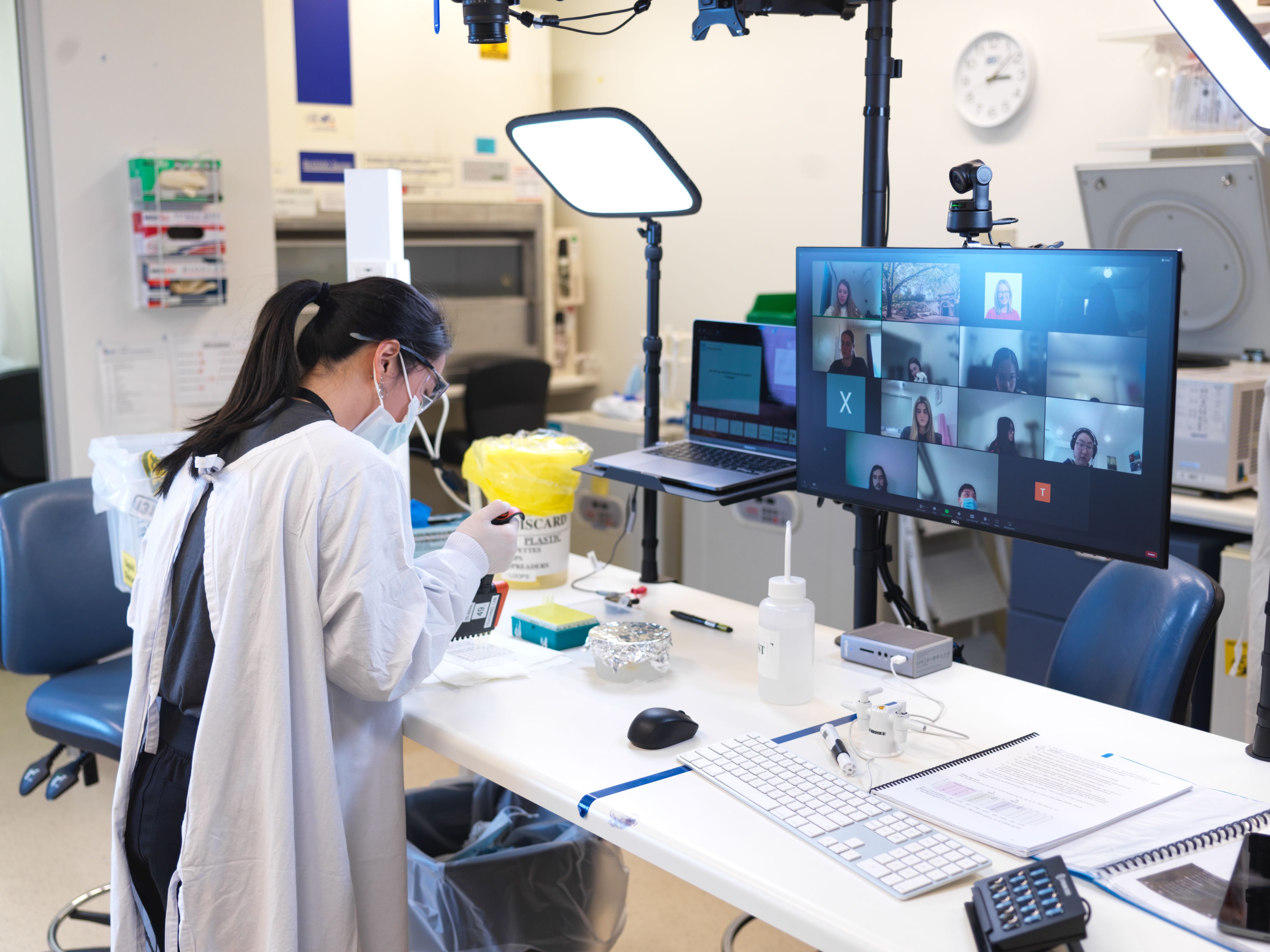Lights, cameras and interactive online learning
When Eleonora Puglia realised that online learning was here to stay for 2021, she quickly became an unexpected expert on interactive learning, developing a state-of-the art technology hub which allowed students to be immersed in practical experiments. Her trusted source of information? Her 14-year-old son.

When you walk into the backroom of the teaching laboratories of the Doherty Institute, you would be forgiven for thinking you had walked into a professional streaming studio.
Multiple cameras are mounted to the bench, another is attached to a microscope and an iPad is docked ready to capture roaming footage in the lab. The system is all linked to an intricate control panel, cables have been neatly secured and additional LED studio lighting ensure the presenter is well lit.
However, the professional system was not designed by an audio-visual expert, or someone with experience in video production. It was created by the Teaching team at the Doherty Institute who realised the need for an interactive learning experience when it came to practical classes.
In an average year, the teaching staff at the Doherty Institute lead 12 practical laboratory subjects for their 5,000 undergraduate and postgraduate students.
The practical classes are a critical component of their teaching, with the students able to gain hands on experience at performing particular techniques and put the theory they learn in lectures into real life context.
While 2020 had seen the team in the preparatory lab (Ms Puglia, Ms Nicole Kountouri, Ms Wendy Larrad and Ms Christine Alaan) do an incredible job at quickly adapting to an online learning model, capturing photos and videos of experiments which students could later view. They were aware the experience was still lacking.
“When we first went online, we had been working with still photos, so the first step taken was recording videos of certain techniques pertinent to the practicals.
“It was a lot better, but the students still weren’t getting the opportunity to interact with us, to look at what was happening on the bench and ask live questions as we worked,” Ms Puglia says.
With no background in video production and having taught herself the basics to establish the video library, she began looking for ways to innovate.
“It started with some of the med students, I just set up a simple tripod and webcam connected to Zoom,” explains Ms Puglia.
“But then they wanted more. They were asking to be able to see the stained slides under the microscope. They wanted to see more and be more involved.”
With no one in the team particularly adept at audio visual and the limitations of lockdown, Ms Puglia turned to a source close to home, her fourteen-year-old son, Antonio.
“He’s really into technology, so he understands the language. I would tell him what I wanted to achieve, and he would just tell me how to achieve it and what I needed to buy,” says Ms Puglia.
“Our control panel for instance, is something gamers use. We’ve programmed in the different camera streams, and it allows us to easily flick between them as we teach.
“Rather than having to return to the computer desktop each time and change programs, we can just hit these shortcuts and go from talking to the camera, to showing an overhead shot of the bench or look at a slide under the microscope. It’s a streamlined experience.”
When the team brought their solutions to University of Melbourne Dr Jessica Welch, Senior Lecturer, she encouraged them to run with it.
“We had actually received a number of funding grants for online learning for various subjects, so we pooled the money to enable Eleanora to purchase the equipment she needed,” explains Dr Welch.
“We had seen what she had achieved in 2020 setting up all the videos, so we trusted her completely to go ahead and purchase what was needed. What she has produced is incredible, she has gone so far above and beyond.”
The system is now so detailed that an instructor can place something under the microscope and ask the students in a Zoom room to circle what they see and annotate it.




The team have since shared their set up with other labs at the university and around the precinct.

University of Melbourne Dr Sophie Paquet-Fifield, a Senior Lecturer at the Doherty Institute, worked with the university’s Innovation and Engagement Manager to create a TikTok showcasing what the system could do and she has since shared it at several international conferences and with teams around the University.
With the laboratory returning to face-to-face learning, the system will still play an important role in the learning experience.
“We use it now in a hybrid format for those students who are unwell, or still living overseas and aren’t able to be here,” says Dr Welch.

“Also having a library of content going forward will be invaluable. Because we are working in a restricted facility, students aren’t allowed to bring their phones in to take photos or record demonstrations like they can in some other labs. To have these materials they can refer to is going to be so useful for them.”
The team also now have a an online practical delivery specialist in teaching lab technical officer Ms Kountouri.
